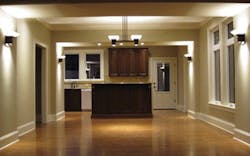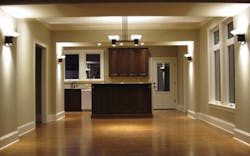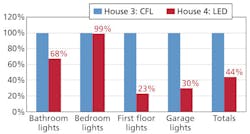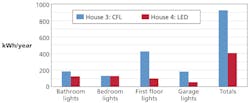VICTOR ZADEREJ reveals the results of LED and fluorescent lighting tested in residences at Oak Ridge National Laboratories and projects how other SSL advancements will impact commercial applications.
Lighting accounts for upward of 10% of total energy use in average US homes and up to 40% in commercial buildings. Conventional incandescent bulbs are woefully inefficient, with only 5–10% of the electricity consumed converted into useable light and the rest wasted as heat. Compact fluorescent lights (CFLs) are more efficient but have often fallen short in terms of performance and longevity. LED-based solid-state lighting (SSL) has made enormous strides since starting out as a novelty niche technology. LEDs are now a viable option in a wide range of applications, as a case study in a residential setting has demonstrated. Moreover, a host of new technologies provide more options in commercial applications as well.
Within the lighting industry, however, leading manufacturers and lighting designers/specifiers recognize that the widespread adoption of energy-efficient light sources will not occur based solely on energy costs. Ultimately, the combination of energy efficiency, design, quality, performance, and price point will determine how much market share LEDs claim against incumbent technologies in commercial and residential applications.
Several years ago, Molex joined with a group of companies and government agencies and begin a project intended to prove that SSL could be used to dramatically reduce energy usage, while providing excellent quality lighting. Results of the Oak Ridge National Laboratories (ORNL) demonstration have now confirmed both the energy savings and how LED lighting quality can be optimized using the right design and technologies.
Methodology: ZEBRA Home #4
A collaboration between the US Department of Energy (DOE), ORNL, Schaad Companies, and the Tennessee Valley Authority (TVA), along with Molex and other commercial partners, formed the Zero Energy Building Research Alliance (ZEBRA). The objective of the alliance was to evaluate the impact of various building systems, HVAC methods, lighting approaches, and appliances to identify the highest-performing options.
ZEBRA constructed four residential homes in Oak Ridge, Tennessee within close proximity to the National Lab. Oak Ridge homes #1 and #2 were identical in size and appearance, as were homes #3 and #4, with differing approaches to construction and subsystems. Lighting was among the subsystems evaluated by the participants. Solid-state LED lighting provided by Molex was installed in home #4 and its energy usage was compared to CFLs used in adjacent home #3.
Kevin Willmorth, owner of Lumenique, LLC, designed the LED lighting in home #4 to demonstrate the capability of LEDs to enhance design, deliver proper illumination levels, and reduce energy use simultaneously. The goal was to make the lighting designs functional and aesthetically attractive. Home #3 featured CFL and linear fluorescent lighting selected from conventional luminaire showroom sources. The completed design resulted in 2.1 W/ft2 in energy usage for lighting in home #3 (Fig. 1, left).
AC-LED fixtures
Home #4 featured new Molex custom GU24 120-VAC LED light sources throughout. No commercial fixture products were available at the time of construction, so Lumenique custom-designed fixtures for this application.
What became the first generation of Molex Transcend light sources comprised an LED product powered directly from AC line voltage built into an assembly that easily snapped into a fixture using a standard GU24 socket. With Transcend, Molex wanted to deliver on the promise of bringing SSL back to the nature of the plug-in socket of traditional light bulbs but with an LED source.
Lumenique designed luminaires to integrate Molex Transcend light sources, each of which contained a single AC-LED module produced by Seoul Semiconductor and provided roughly 150 lm of warm 3000K-CCT light and consumed 4W of power. The light level was not nearly as high as today’s greater than 1000-lm LED light sources, but with a proper lighting design, the team achieved excellent results. Lumenique’s design approach focused lighting where it was needed to avoid waste and glare. Moreover, the efficient LED sources enabled a layered approach with accent lighting while still enabling energy reduction relative to house #3. Indeed, Lumenique calculated optimum light levels in different living areas, utilizing illuminance renderings and numeric calculations to visualize light patterning. The completed design resulted in less than 0.3 W/ft2 in energy for the lighting in home #4 (Fig. 1, right).
The homes were unoccupied between 2010 and 2012. Occupancy was simulated through automation and robotic control, minimizing the potential for differences due to occupancy habits. All aspects of energy use within the homes were measured and data was collected for two years. Homes #3 and #4 were identical in style and size. Both homes were controlled to the same duty cycle, and the two homes had the same wired light circuits for making a fair comparison between SSL and CFL light sources.
The four homes were monitored continuously for two consecutive years by Oak Ridge and the TVA. After two years of field data collection, the lighting energy load in home #4 using the LED lighting system was shown to be 55% less compared to home #3, which was equipped with CFLs (Fig. 2). The results prove not only energy savings but the aesthetic value of a total lighting design approach, rather than focusing exclusively on lumens per watt.
According to Dr. Bill Miller, Oak Ridge National Laboratory, who was responsible for the design and construction of the homes, the performance of the LED-lit home was even better than the team had anticipated. “The lighting effects and data illustrate how LED results can be optimized for residential home use by integrating the right technologies and design scheme,” states Miller.
In final visual comparisons, the LED-equipped home provided more task lighting with less glare, and improved appearance and color in a number of areas over the CFL-equipped home. According to the Home Energy Rating System, the ZEBRA homes had a rating of about 45, which indicates a 55% energy savings compared to conventional code-built homes. LEDs resulted in significant energy reduction throughout the house (e.g., 42% reduction in main entry, 65% den, 60% dining room, 70% living room, 73% kitchen; Fig. 3).
Transformational design platform
Beyond energy savings, it’s important to look at how LEDs can add value to lighting designs. CFL has long been a mainstay recommendation for efficient lighting. However, CFLs can offer neither the energy savings nor design flexibility of directional LEDs. Early attempts to retrofit LEDs into existing lighting fixtures and shades produced less than desirable illumination and shadows. The high cost and low quality of LED illumination turned off some consumers accustomed to economical incandescent bulbs. Longevity and energy savings appealed to early adopters, many of whom felt shortchanged, paying more for products that delivered inferior lighting effects.
Despite a slow start, estimates show market growth with LED technologies projected to meet approximately 50% of all lighting by 2020. Industry focus has shifted from well-documented energy savings to how best to make aesthetically appealing, more functional LED products that consumers want. Capable of emitting a higher quality and quantity of light without sacrificing energy efficiency, today’s LED technologies can provide more than replacement value. The right blend of technologies can offer a transformational platform to create entirely new and unique lighting designs.
Compared to today’s technologies, the LED modules used in Oak Ridge were not very bright but were sufficient with proper placement. Many newer LED products are modular and thinner, and provide equivalent or better light quality and aesthetics than CFL and incandescent bulbs. The quality of light provided by next-generation LED chips has dramatically improved and LED lamps now come standard to 1000 lm. Molex Transcend light sources have also evolved since Oak Ridge to feature a magnetic low-voltage interface so users can effortlessly configure, adjust, upgrade, or replace light sources on site as simply as changing light bulbs of the past. The power rail and power sockets eliminate the need for additional power attachments. The total light source package integrates optics, thermal management, and electronics to reduce time to market on new lighting designs.
By eliminating AC power, Transcend low-voltage light sources are even safer, easier to install, and transferable anywhere throughout a home or commercial space. Powered by a 24-VDC Class 2 power supply, the latest Transcend portfolio offers a range of lumen outputs, color temperatures, and beam angles. These products all work with the same track and power supply for adaptability to a variety of fixtures, including undercabinets, linear pendants, and downlight cans, in addition to decorative and flush-mount fixtures in residential, retail, hospitality, and commercial applications. Manufacturers can choose from a range of lumen output and CRI (color rendering index) options over 95 with a wider directional capacity to achieve illumination levels that more closely resemble traditional 60–100W incandescent bulbs.
Next-gen LED systems: Integration and innovation
Pairing LED technology with a self-contained, modular design has the potential to dramatically change the way users can interact with lighting. Continuous power rails, or single power sockets and magnetic light modules, allow users to create lighting effects, and change brightness or ambience themes as often as they wish. The user simply places a module anywhere along the top or bottom of an installed magnetic rail or into a single magnetic socket to produce instant illumination. More light simply requires adding brighter or more modules. By repositioning modules, one can quickly set up a task staging area or create a dramatic effect. The bold, modern, and smart approach allows users to determine the right, individualized level of brightness for their commercial or residential space.
Design innovation, quality, ease of use, and aesthetics will remain critical challenges to LED development. Being a lower-power light source, LEDs offer an ideal blend of energy savings and design flexibility. The LED price factor needs to be addressed through greater integration of the heat sink and power supply. Optics can be optimized with the LED to improve quality and drive down cost. Heat-generating silicon chips can be managed by integrating low-voltage magnetic rails that transfer heat away from the LED and into the fixture surface where it disperses the heat.
Newer products go well beyond traditional bulb delivery systems, with newer LED designs featuring easy, fun, and changeable colors, brightness, and color temperature. Using magnetically coupled LEDs with 12 or 24 VDC, rather than traditional 120-VAC power, lowers the voltage to enable maximum portability within a space, without high installation costs or risk of electrical shock to the user. Low-voltage lighting also reduces the capacitor burnout risk associated with the power supplied in LED bulbs.
Low-voltage 12V or 24V power for LED lighting can be delivered in a number of ways. Technologies such as solar and wind allow the storage and use of renewable energy without having to convert it through a separate power brick. A further benefit of direct voltage power conversion is being able to simultaneously power multiple devices. In more traditional homes, conversion of line to low voltage offers opportunities to enhance control while reducing individual fixture unit costs by eliminating redundant power supplies.
Longer-term options for providing power for lighting in commercial applications include Power over Ethernet (PoE). With many existing buildings already wired for PoE to bring power and data to computers, phones, access points, and security cameras, etc., it is an easy transition to add low-voltage lighting and controls to the list. Standard Cat5e/Cat6 cables along with standard RJ45 connectors would provide both power and control functionality such as dimming, emergency lighting and notification, energy harvesting, and security.
Leverage LED design and technological characteristics
The Oak Ridge project provided a valuable glimpse at how technology and science can make dramatic changes in the cost of heating, cooling, and lighting energy use. Choosing the right technologies and exploiting the advantages of LED-based light sources can improve lighting design of residential homes and commercial buildings, and reduce energy consumption by as much as 55% when compared with CFL or 80% compared with traditional incandescent bulbs. In review of the completed project in terms of the current state of technology, Willmorth estimates an additional 45% energy savings could be realized while retaining all gains in lighting quality, plus additional savings and performance from being able to apply more refined control using distributed low-voltage technology.
As production ramps up on reliable and appealing SSL designs, LEDs become a more attractive option for OEMs and a better value in the eyes of consumers. The industry can expect continued technological and design improvements. New and better approaches to power and control low-voltage LED lighting can add significant intelligence to lighting systems and accelerate customer return on investment through energy savings, reduced energy costs, and elimination of copper wires. These methods can also revolutionize how lights and buildings are powered, controlled, and optimized.
Costs will decrease as LED products become mainstream, providing opportunities to make strides into the residential market in ways that CFL failed — and is incapable of. Solid-state LED lighting is rapidly becoming the best option for high-quality, dimmable, and low-energy lighting. In time, as has been demonstrated here, it is inevitable that this will have a significant impact on the residential lighting market, which has to date been resistant to change based solely on energy efficiency.
VICTOR ZADEREJ is the SSL advanced product development manager at Molex Inc.









